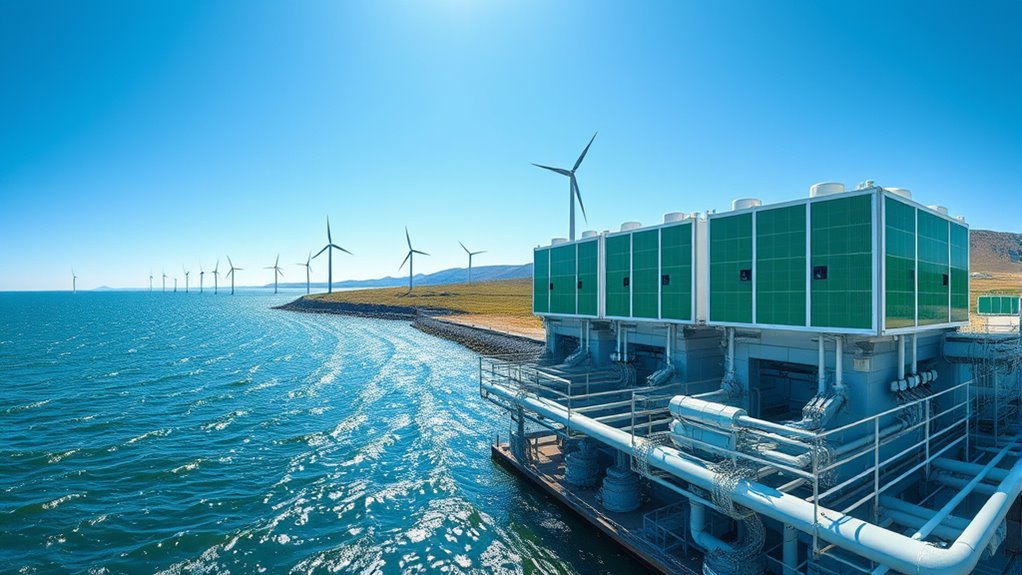Green hydrogen projects are expanding rapidly worldwide, driven by advancements in renewable electrolysis and storage solutions. These initiatives help decarbonize industries, power, and transportation, while also balancing renewable energy grids. Investments from governments and private companies are creating resilient infrastructure to support this clean energy shift. As costs drop and technology improves, green hydrogen becomes more viable. Stay with us to discover the most exciting projects shaping the future of sustainable energy.
Key Takeaways
- Global investments in large-scale green hydrogen electrolysis projects are accelerating, driven by renewable energy integration and policy support.
- Innovative storage solutions like metal hydrides and underground caverns are enhancing the safety and efficiency of hydrogen transport.
- Major infrastructure developments are linking renewable energy farms with hydrogen production and distribution hubs worldwide.
- Countries are launching ambitious green hydrogen initiatives to decarbonize industries, shipping, and power sectors.
- Cost reductions and technological advancements are making green hydrogen more competitive and attractive for diverse applications.

Have you ever wondered how hydrogen is shaping the future of clean energy? As the world shifts toward sustainable solutions, green hydrogen stands out as a promising contender. It’s produced through renewable electrolysis, a process that uses electricity generated from wind or solar power to split water into hydrogen and oxygen. This method guarantees the hydrogen is truly green, free from carbon emissions. But for hydrogen to become a mainstream energy source, efficient storage is essential. Hydrogen storage solutions are advancing rapidly, making it easier to hold and transport this lightweight fuel safely and effectively. High-pressure tanks, metal hydrides, and underground cavern storage are just a few of the technologies gaining traction, addressing one of hydrogen’s biggest challenges—its low density and volatility.
Hydrogen storage advances are key to making green hydrogen a viable, safe, and efficient clean energy source.
Renewable electrolysis is at the heart of green hydrogen projects. It allows for the production of hydrogen using clean energy, which is fundamental for reducing reliance on fossil fuels. Large-scale electrolysis facilities are emerging worldwide, often linked to renewable energy farms, creating a seamless cycle of generation and utilization. These projects not only produce hydrogen but also help balance the grid by absorbing excess renewable energy during peak times, preventing wastage. As these systems grow more efficient and cost-effective, they’re poised to revolutionize sectors like transportation, industry, and power generation. Additionally, innovations in hydrogen storage technologies are crucial for expanding the reach and practicality of green hydrogen.
You’ll also notice that advancements in hydrogen storage directly impact the feasibility of green hydrogen projects. Without reliable storage options, transporting hydrogen over long distances remains a hurdle. But new innovations are making it possible to store hydrogen more safely and compactly, whether in compressed form, liquid, or solid-state materials. This flexibility means that green hydrogen can be produced in remote locations with abundant renewable resources and then transported to demand centers, boosting the overall viability of hydrogen economies.
Furthermore, governments and private companies are investing heavily in these technologies, recognizing hydrogen’s potential to decarbonize heavy industries, shipping, and even aviation. These projects aim to create a resilient infrastructure that supports a hydrogen-based energy system. As renewable electrolysis becomes more widespread and hydrogen storage solutions improve, the cost of green hydrogen will continue to drop, making it an attractive alternative to fossil fuels.
In the coming years, expect to see more ambitious projects that integrate renewable electrolysis with advanced storage methods. This synergy will accelerate the transition toward a sustainable energy future, helping you and the planet breathe easier. Hydrogen isn’t just a buzzword anymore; it’s becoming a cornerstone of clean energy initiatives worldwide, promising a greener, more resilient future.
Frequently Asked Questions
What Are the Main Challenges Facing Green Hydrogen Project Development?
You face technological hurdles like developing cost-effective electrolysis methods and ensuring efficient storage. Infrastructure needs are also significant; building widespread pipelines and fueling stations requires substantial investment and planning. These challenges can slow down green hydrogen project development, but with innovation and collaboration, you can overcome them. Addressing technological and infrastructure issues is essential for scaling up green hydrogen and making it a viable, sustainable energy source.
How Does Green Hydrogen Compare in Cost to Grey Hydrogen?
You’ll find that green hydrogen currently costs more than grey hydrogen, mainly due to the high expenses of renewable energy and electrolysis. However, as technology advances and renewable energy becomes cheaper, the cost comparison is expected to shift, improving green hydrogen’s economic viability. This trend makes green hydrogen increasingly competitive, especially with policy support and economies of scale, paving the way for broader adoption and sustainable energy solutions.
What Are Potential Safety Concerns With Large-Scale Hydrogen Storage?
You should be aware that large-scale hydrogen storage poses safety concerns like storage hazards, including the risk of leaks or explosions if containment fails. To guarantee safety, you need strict leak prevention measures, such as proper sealing, regular inspections, and advanced monitoring systems. Managing these risks is vital because hydrogen’s flammability and low ignition energy make leaks potentially dangerous, especially in enclosed or high-pressure environments.
How Will Green Hydrogen Impact Global Energy Markets?
Imagine a new dawn in energy markets, where green hydrogen transforms how you power your world. Market adoption accelerates as technological innovation makes green hydrogen more affordable and efficient. This shift could lower fossil fuel reliance, drive economic growth, and create new industries. Your role in this evolution is vital, as widespread green hydrogen use reshapes global energy dynamics, paving the way for a cleaner, more sustainable future.
What Policies Are Most Effective in Supporting Green Hydrogen Initiatives?
You should focus on implementing strong policy incentives and clear regulatory frameworks to support green hydrogen initiatives. These policies encourage investment by reducing costs and providing financial support, while robust regulations guarantee safety and standardization. By fostering a stable policy environment, you can attract public and private sector participation, accelerate technology development, and help scale green hydrogen production, making it a crucial part of the clean energy transition.
Conclusion
You’re witnessing the dawn of a fuel revolution so powerful, it could transform the entire planet overnight. Green hydrogen projects are not just promising—they’re unstoppable forces that will redefine energy as you know it. As these projects skyrocket, you’ll see a future where clean, limitless energy fuels every corner of your life, making fossil fuels seem like ancient history. Get ready—you’re on the brink of a green energy explosion that’ll reshape the world forever!









